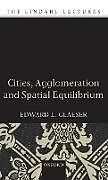Cities, Agglomeration, and Spatial Equilibrium
Einband:
Fester Einband
EAN:
9780199290444
Untertitel:
Englisch
Genre:
Volkswirtschaft
Autor:
Edward L. Glaeser
Herausgeber:
Oxford Academic
Anzahl Seiten:
286
Erscheinungsdatum:
03.07.2008
ISBN:
978-0-19-929044-4
Zusatztext Provides insights into the most recent theoretical advances achieved in a specific area of urban economics...recommended. Informationen zum Autor Edward L. Glaeser is a Professor of Economics at Harvard University, where he has taught since 1992. He teaches urban and social economics and microeconomic theory, and has published dozens of papers on cities, economic growth, and law and economics. He is a Faculty Research Fellow for the National Bureau of Economic Research, and has also been a consultant for numerous international international institutions. Klappentext Drawing on his successful Lindahl lectures, Edward Glaeser provides a rigorous account of his research and unique thinking on cities. Written for an advanced audience with an interest in urban economics and cities, the book is written to be accessible to theorists and non-theorists alike and should provide a basis for further empirical work. Zusammenfassung 220 million Americans crowd together in the 3% of the country that is urban. 35 million people live in the vast metropolis of Tokyo, the most productive urban area in the world. The central city of Mumbai alone has 12 million people, and Shanghai almost as many. We choose to live cheek by jowl, in a planet with vast amounts of space. Yet despite all of the land available to us, we choose to live in proximity to cities. Using economics to understand this phenomenon, the urban economist uses the tools of economic theory and empirical data to explain why cities exist and to analyze urban issues such as housing, education, crime, poverty and social interaction.Drawing on the success of his Lindahl lectures, Edward Glaeser provides a rigorous account of his research and unique thinking on cities. Using a series of simple models and economic theory, Glaeser illustrates the primary features of urban economics including the concepts of spatial equilibrium and agglomeration economies. Written for a mathematically inclined audience with an interest in urban economics and cities, the book is written to be accessible to theorists and non-theorists alike and should provide a basis for further empirical work....
Autorentext
Edward L. Glaeser is a Professor of Economics at Harvard University, where he has taught since 1992. He teaches urban and social economics and microeconomic theory, and has published dozens of papers on cities, economic growth, and law and economics. He is a Faculty Research Fellow for the National Bureau of Economic Research, and has also been a consultant for numerous international international institutions.
Klappentext
Drawing on his successful Lindahl lectures, Edward Glaeser provides a rigorous account of his research and unique thinking on cities. Written for an advanced audience with an interest in urban economics and cities, the book is written to be accessible to theorists and non-theorists alike and should provide a basis for further empirical work.
Zusammenfassung
220 million Americans crowd together in the 3% of the country that is urban. 35 million people live in the vast metropolis of Tokyo, the most productive urban area in the world. The central city of Mumbai alone has 12 million people, and Shanghai almost as many. We choose to live cheek by jowl, in a planet with vast amounts of space. Yet despite all of the land available to us, we choose to live in proximity to cities. Using economics to understand this phenomenon, the urban economist uses the tools of economic theory and empirical data to explain why cities exist and to analyze urban issues such as housing, education, crime, poverty and social interaction. Drawing on the success of his Lindahl lectures, Edward Glaeser provides a rigorous account of his research and unique thinking on cities. Using a series of simple models and economic theory, Glaeser illustrates the primary features of urban economics including the concepts of spatial equilibrium and agglomeration economies. Written for a mathematically inclined audience with an interest in urban economics and cities, the book is written to be accessible to theorists and non-theorists alike and should provide a basis for further empirical work.
Inhalt
1. Introduction; 2. The Spatial Equilibrium Within the City; 3. The Spatial Equilibrium Across; 4. Agglomeration Economies; 5. Urban Distress; 6. Cities and Public Policy

Leider konnten wir für diesen Artikel keine Preise ermitteln ...
billigbuch.ch sucht jetzt für Sie die besten Angebote ...
Die aktuellen Verkaufspreise von 6 Onlineshops werden in Realtime abgefragt.
Sie können das gewünschte Produkt anschliessend direkt beim Anbieter Ihrer Wahl bestellen.
Loading...
Die aktuellen Verkaufspreise von 6 Onlineshops werden in Realtime abgefragt.
Sie können das gewünschte Produkt anschliessend direkt beim Anbieter Ihrer Wahl bestellen.
| # | Onlineshop | Preis CHF | Versand CHF | Total CHF | ||
|---|---|---|---|---|---|---|
| 1 | Seller | 0.00 | 0.00 | 0.00 |
